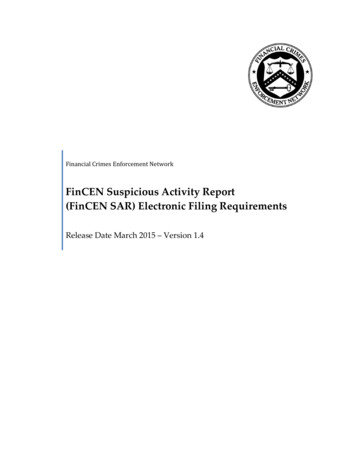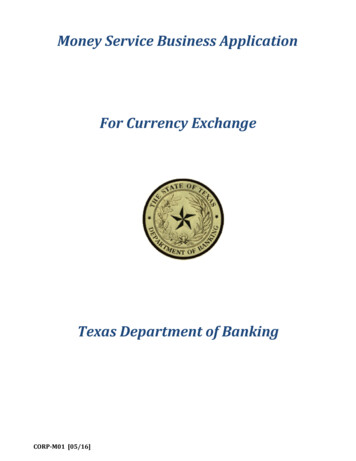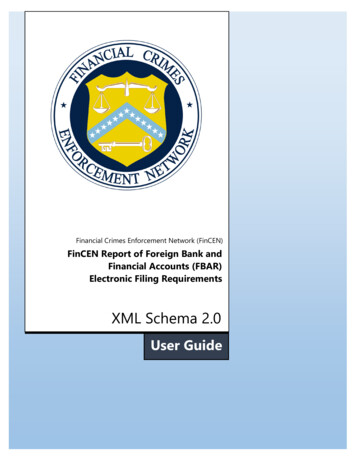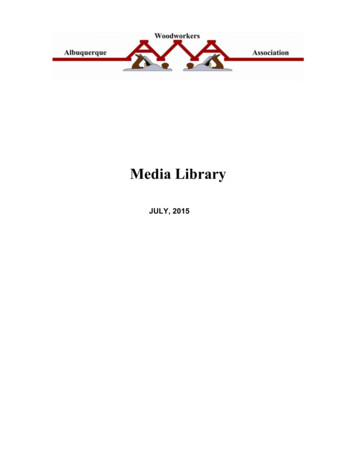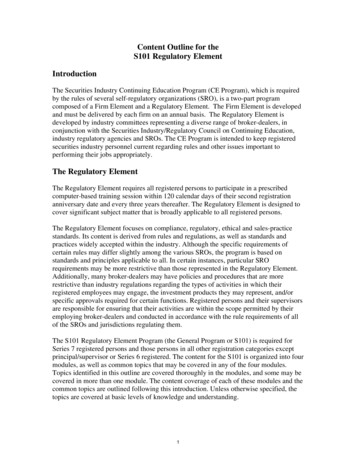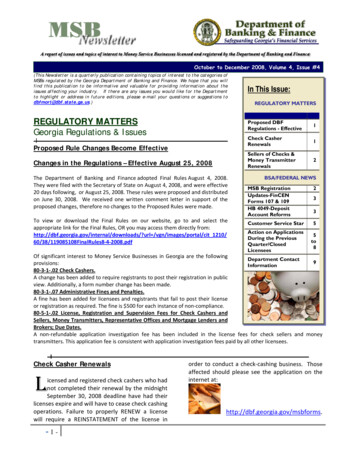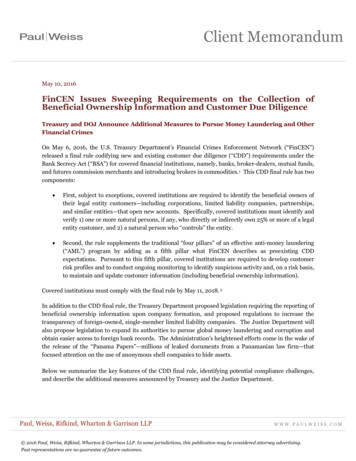
Transcription
May 10, 2016FinCEN Issues Sweeping Requirements on the Collection ofBeneficial Ownership Information and Customer Due DiligenceTreasury and DOJ Announce Additional Measures to Pursue Money Laundering and OtherFinancial CrimesOn May 6, 2016, the U.S. Treasury Department’s Financial Crimes Enforcement Network (“FinCEN”)released a final rule codifying new and existing customer due diligence (“CDD”) requirements under theBank Secrecy Act (“BSA”) for covered financial institutions, namely, banks, broker-dealers, mutual funds,and futures commission merchants and introducing brokers in commodities.1 This CDD final rule has twocomponents: First, subject to exceptions, covered institutions are required to identify the beneficial owners oftheir legal entity customers—including corporations, limited liability companies, partnerships,and similar entities—that open new accounts. Specifically, covered institutions must identify andverify 1) one or more natural persons, if any, who directly or indirectly own 25% or more of a legalentity customer, and 2) a natural person who “controls” the entity. Second, the rule supplements the traditional “four pillars” of an effective anti-money laundering(“AML”) program by adding as a fifth pillar what FinCEN describes as preexisting CDDexpectations. Pursuant to this fifth pillar, covered institutions are required to develop customerrisk profiles and to conduct ongoing monitoring to identify suspicious activity and, on a risk basis,to maintain and update customer information (including beneficial ownership information).Covered institutions must comply with the final rule by May 11, 2018. 2In addition to the CDD final rule, the Treasury Department proposed legislation requiring the reporting ofbeneficial ownership information upon company formation, and proposed regulations to increase thetransparency of foreign-owned, single-member limited liability companies. The Justice Department willalso propose legislation to expand its authorities to pursue global money laundering and corruption andobtain easier access to foreign bank records. The Administration’s heightened efforts come in the wake ofthe release of the “Panama Papers”—millions of leaked documents from a Panamanian law firm—thatfocused attention on the use of anonymous shell companies to hide assets.Below we summarize the key features of the CDD final rule, identifying potential compliance challenges,and describe the additional measures announced by Treasury and the Justice Department. 2016 Paul, Weiss, Rifkind, Wharton & Garrison LLP. In some jurisdictions, this publication may be considered attorney advertising.Past representations are no guarantee of future outcomes.
The CDD Final RuleThe CDD final rule has two main components: a new requirement to identify beneficial owners of legalentity customers, and the addition of a “fifth pillar” relating to CDD expectations into the AML programrequirements for each covered financial institution.Requirement to Identify Beneficial Ownership. Covered financial institutions are required tomaintain written procedures, incorporated into their AML compliance programs, to identify the followingnatural persons for each of their legal entity customers—subject to certain exceptions3—that open newaccounts on or after the “applicability date” (May 11, 2018):1.Ownership. Each individual, if any, who, directly or indirectly, through any contract,arrangement, understanding, relationship or otherwise, owns 25 percent or more of the equityinterests of a legal entity customer; and2. Control. A single individual with significant responsibility to control, manage, or direct a legalentity customer, including (i) An executive officer or senior manager (e.g., a Chief ExecutiveOfficer, Chief Financial Officer, Chief Operating Officer, Managing Member, General Partner,President, Vice President, or Treasurer); or (ii) Any other individual who regularly performssimilar functions.4The number of individuals satisfying the definition of beneficial owner will vary from entity to entity.Under the first test, up to four individuals (and as few as zero) may need to be identified. Under thesecond test, at least one individual must be identified.Covered institutions must identify and verify the identities of the requisite individuals at the time the newaccount is opened. This can be done either by obtaining a certification in the form of Appendix A to thefinal rule from the individual opening the account on behalf of the legal entity, or by obtaining the sameinformation by another means, provided that the individual certifies the accuracy of the information.5The identification and verification procedures are, according to FinCEN, very similar to those forindividual customers under a covered institution’s customer identification program (“CIP”).6 Alsoconsistent with current CIP obligations, covered institutions will be required to maintain records of thebeneficial ownership information they obtain, and they may rely on other financial institutions for theperformance of the requirements, provided that the other financial institution meets certainrequirements.7This beneficial ownership requirement is a significant addition to the BSA/AML regime. Historically,beneficial ownership reporting was required in two limited circumstances.8 The new requirement, alongwith the part of the rule that clarifies CDD requirements more generally, will better align the UnitedStates with international AML standards established by the Financial Action Task Force and otherinternational bodies.9 The requirement, according to FinCEN, is designed to address the fact that covered2
institutions are “not presently required to know the identity of the individuals who own or control theirlegal entity customers,” which enables “criminals, kleptocrats, and others looking to hide ill-gottenproceeds to access the financial system anonymously.”10Adding CDD as a Fifth Pillar to AML Program Requirements. The BSA requires certainfinancial institutions to establish anti-money laundering (AML) programs, which, “at a minimum,” havefour elements. These four elements are considered by FinCEN and other regulators as the “four pillars” ofan effective AML program. In the CDD final rule, FinCEN codified these four pillars in the FinCENregulations pertaining to each type of covered financial institution and added a fifth multi-part pillarpertaining to CDD.11 As a result of the final rule, the five pillars fundamental to an effective AML programfor these covered institutions are generally as follows:1.A system of internal controls to assure ongoing compliance;2. Independent testing for compliance to be conducted by financial institution personnel or byan outside party;3. Designation of an individual or individuals responsible for coordinating and monitoring dayto-day compliance;4. Training for appropriate personnel; and5. Appropriate risk-based procedures for conducting ongoing customer due diligence, toinclude, but not limited to:(i)Understanding the nature and purpose of customer relationships for thepurpose of developing a customer risk profile; and(ii)Conducting ongoing monitoring to identify and report suspicioustransactions and, on a risk basis, to maintain and update customerinformation. For purposes of this paragraph (5)(ii), customer informationshall include information regarding beneficial owners of legal entitycustomers (as defined by the final rule).12With respect to (5)(i), FinCEN explained that “a customer risk profile refers to the information gatheredabout a customer at account opening used to develop a baseline against which customer activity isassessed for suspicious activity reporting.” This may include “self-evident information such as the type ofcustomer or type of account, service, or product.” The profile “may, but need not, include a system of riskratings or categories of customers.”133
With respect to (5)(ii), FinCEN explained that when a covered institution detects information about acustomer in the normal course of monitoring—such as a significant and unexplained change in thecustomer’s activity (for example, executing a cross-border wire transfer for no apparent reason)—that isrelevant to “assessing or reevaluating the risk posed by the customer,” the institution must “update thecustomer information, including beneficial ownership information.”14In response to public comments, FinCEN emphasized its belief that the fifth pillar encompasses“necessary and critical steps required to comply” with the existing requirement under the BSA to identifysuspicious activity and file Suspicious Activity Reports.15 Incorporating these existing CDD expectationsinto the AML program requirements was meant to promote “uniformity and consistency” across thevarious categories of financial institutions, which will “strengthen the system as a whole, by furtherlimiting opportunities for inconsistent application of unclear or unexpressed expectations.”16Compliance Challenges Posed by the Final RuleAs a significant new rule in the BSA/AML regime, covered institutions will face compliance andinterpretive challenges. Under a risk-based framework, there will be considerable uncertainty as to howvigorously FinCEN, the banking regulators, and the other agencies involved in AML enforcement willexpect covered financial institutions to act in performing customer due diligence, putting to use the newbeneficial ownership information obtained, and complying with the new fifth pillar of an effective AMLcompliance program. While FinCEN believes that this fifth pillar codifies existing expectations rooted insuspicious transaction reporting obligations, there is reason to think that the fifth pillar will take on a lifeof its own, serving as a touchstone for increasingly demanding expectations on the part of regulators. Inaddition, because CDD practices currently vary across sectors, covered institutions may face challenges inunderstanding the single CDD standard that FinCEN has now established across these sectors.The following are some examples of the challenges posed by the final rule.Reliance on Beneficial Ownership Information Supplied by Customer. Under the final rule,covered financial institutions must generally verify only the existence of an identified beneficial owner andnot the individual’s status as a beneficial owner. FinCEN provides that covered institutions may rely onthe beneficial ownership information supplied by the customer, provided that they have “no knowledge offacts that would reasonably call into question the reliability” of the information.17 FinCEN has stated that“in the overwhelming majority of cases, a covered financial institution should be able to rely on theaccuracy of the beneficial owner or owners identified by the legal entity customer, absent the institution’sknowledge to the contrary.” The rule creates a fairly forgiving standard, but also a murky one, invitingregulators to second-guess a financial institution’s reliance on its customer’s beneficial ownershipinformation. Among other things, regulators may hold institutions responsible for knowledge held in onepart of its operations, however distant from the function that performs diligence on new accounts.4
Collection of Beneficial Ownership Information on Existing Customers. While the beneficialownership requirements apply only to new accounts opened on or after May 11, 2018, the ongoingmonitoring requirement contained in the new fifth pillar will require a financial institution, if it detects“information relevant to assessing or reevaluating the [customer’s risk],” to update customer information,including collection or updating of beneficial ownership information. FinCEN has emphasized that thisprovision “does not impose a categorical requirement that financial institutions must update customerinformation, including beneficial ownership information, on a continuous or periodic basis,” and that theneed to update will be “event-driven.”18 Nevertheless, covered institutions may have some well-deserveduncertainty as to the expectations that regulators will have regarding the extent and frequency of updatingsuch information.Expectations Regarding the Ownership Threshold for Beneficial Owners. For the ownershipprong, FinCEN required that covered institutions identify owners of 25% or more of the legal entitycustomer, and rejected proposals that that threshold be lowered to 10%. Nevertheless, FinCEN statedthat:[T]he 25 percent threshold is the baseline regulatory benchmark, but that covered financialinstitutions may establish a lower percentage threshold for beneficial ownership . . . based ontheir own assessment of risk in appropriate circumstances. As a general matter, FinCEN doesnot expect covered financial institutions’ compliance with this regulatory requirement to beassessed against a lower threshold. Nevertheless, consistent with the risk-based approach,FinCEN anticipates that some financial institutions may determine that they should identify andverify beneficial owners at a lower threshold in some circumstances; we believe that making thisclear in the note accompanying the regulator text will aid them in doing so with respect to theircustomers.19Additionally, the final rule provides: “A covered financial institution may also identify additionalindividuals as part of its customer due diligence if it deems appropriate on the basis of risk.”20 Thus, eventhe rule’s 25% threshold appears to yield to the risk-based principle. Covered institutions should considerwhether a lower threshold is appropriate for certain customers or classes of customers.Heightened Expectations for Uses of Beneficial Ownership Information. FinCEN has statedthat it expects covered institutions to use the beneficial ownership information collected to “comply withother requirements,” such as Office of Foreign Assets Control (“OFAC”) sanctions compliance. FinCENalso noted that it expects institutions to use beneficial ownership information to comply with CurrencyTransaction Reporting (“CTR”) requirements, including the need to aggregate transactions that are “by oron behalf of” the same person for purposes of complying with the 10,000 threshold transactionrequirement. FinCEN has stated that beneficial ownership information may give a covered institutionknowledge that a legal entity customer or customers are not being operated independently from eachother or a primary owner, thus making it incumbent on the covered institution to aggregate transactions.5
This is an example of how the increased information that will result from the rule will heighten regulators’expectations of an institution’s ability to connect the dots in the course of AML compliance.Additional Treasury and Justice Department MeasuresWith an urgency stemming from the “Panama Papers,” the Administration has announced additionalregulatory and legislative proposals to combat money laundering and other financial crimes.Treasury Measures. In addition to announcing the final CDD rule, the Treasury Departmentannounced that it would send new beneficial ownership legislation to Congress.21 The legislation wouldrequire U.S. companies to compile beneficial ownership information at the time of their creation and tofile such information with the Treasury Department for use by law enforcement.22 The legislation wouldalso clarify FinCEN’s ability to collect bank wire transfer information and other information throughGeographic Targeting Orders (“GTOs”), which allow FinCEN to impose special reporting requirements onfinancial institutions in targeted geographic areas for limited periods of time. (Recent GTOs requirecertain U.S. title insurance companies to report beneficial ownership information of entities making allcash purchases of high-value residential real estate, in an effort to battle financial crimes in the real estatesector.23)Additionally, Treasury announced proposed regulations to reduce tax evasion. According to Treasury,certain foreign-owned U.S. entities (most notably single-member LLCs) have no obligation to obtain a taxidentification number and report information to the IRS. Among other things, the proposed regulationswould require entities such as foreign-owned single-member LLCs to report ownership and transactioninformation to the IRS, and to obtain employer identification numbers (“EINs”).24Justice Department Measures: Targeting International Corruption and Financial Crime.In addition to these measures, the Justice Department stated that it will propose legislative amendmentsto expand its authority to combat international corruption and money laundering.25 Among other things,the proposed amendments would make it easier for U.S. prosecutors to charge money launderers and torecover the proceeds of government corruption abroad. The amendments seek to achieve this byexpanding foreign money laundering predicates to include additional violations of foreign law that wouldbe a money laundering predicate if committed in the U.S., allowing U.S. prosecutors to further pursuecases involving foreign corruption and to prosecute for money laundering the use of proceeds from awider range of foreign corruption activities.The proposed amendments would, among other things, also (1) enhance law enforcement’s ability toobtain legally admissible foreign bank records through subpoenas served on U.S.-based branches; (2)allow U.S. law enforcement authorities to issue administrative subpoenas in money launderinginvestigations rather than grand jury subpoenas (which must be authorized by a federal prosecutor and6
are subject to secrecy requirements); and (3) create a framework for the use of classified information inkleptocracy-related civil asset recovery cases.If adopted, these changes would expand the authority of the Justice Department to prosecute moneylaundering- and corruption-related offenses while lessening administrative burdens to investigating suchconduct. These developments, if enacted, portend a possible increase in both the number and breadth ofDepartment of Justice and other regulatory investigations related to these issues.The CDD final rule is available here.***This memorandum is not intended to provide legal advice, and no legal or business decision should bebased on its content. Questions concerning issues addressed in this memorandum should be directed to:Jack Baughman212-373-3021jbaughman@paulweiss.comH. Christopher Boehning212-373-3061cboehning@paulweiss.comSusanna M. Buergel212-373-3553sbuergel@paulweiss.comJessica S. Carey212-373-3566jcarey@paulweiss.comRoberto Finzi212-373-3311rfinzi@paulweiss.comMichael E. Gertzman212-373-3281mgertzman@paulweiss.comRoberto J. Gonzalez202-223-7316rgonzalez@paulweiss.comMichele Hirshman212-373-3747mhirshman@paulweiss.comBrad S. Karp212-373-3316bkarp@paulweiss.comMark F. x Young K. Oh202-223-7334aoh@paulweiss.comLorin L. Reisner212-373-3250lreisner@paulweiss.comTheodore V. Wells Jr.212-373-3089twells@paulweiss.comJustin D. Lerer212-373-3766jlerer@paulweiss.comRichard C. s Jeffrey Newton, Andrew Reich and Anand Sithian contributed to this client memorandum.7
See Customer Due Diligence Requirements for Financial Institutions, May 6, 2016 (not yet published inFederal Register), available at http://federalregister.gov/a/2016-10567. While the Final Rule was issuedby the Treasury Department, this article refers to FinCEN throughout for convenience. In a separateproposed rule, FinCEN seeks to require registered investment advisors to establish anti-moneylaundering programs and to report suspicious activity. As proposed, that rule would not subjectinvestment advisors to the requirements of this CDD rule. See 80 Fed. Reg. 169, 52680 at 52681 (Sept. 1,2015), available at 5-21318.pdf.1The final rule will be published in the Federal Register on May 11, 2016 and will become effective 60days thereafter.23 As compared to the proposed rule, the final rule expands the list of exemptions—that is, types ofcustomer entities for which financial institutions will not be required to collect beneficial ownershipinformation. These include certain financial institution clients, government agencies, and state-regulatedinsurance companies, among others. The exemptions recognize instances where AML risk is low andbeneficial ownership information is already publically available from other credible sources. SeeCustomer Due Diligence Requirements for Financial Institutions at 61.4Id. at 207–08 (to be codified at 31 C.F.R. § 1010.230(d)(1)–(2)).5Id. at 3–4.6Id.7Id. at 213–15 (to be codified at 31 C.F.R. § 1010.230(i)–(j)).First, under FinCEN regulations implementing Section 312 of the USA PATRIOT Act, covered financialinstitutions offering private banking accounts are required to take reasonable steps to identify thenominal and beneficial owners of such accounts. (31 CFR § 1010.620(b)(1).) Second, covered financialinstitutions offering correspondent accounts for certain foreign financial institutions are required to takereasonable steps to obtain information from the foreign financial institution about the identity of anyperson with authority to direct transactions through any correspondent account that is a payable-throughaccount, and the sources and beneficial owner of funds or other assets in the payable-through account.(31 CFR § 1010.610(b)(1)(iii)(A).)89Customer Due Diligence Requirements for Financial Institutions at 17.10Id. at 2.11 In the final rule, FinCEN also outlined what it describes as the four elements of a minimal CDDprogram: (1) customer identification and verification; (2) beneficial ownership identification andverification; (3) understanding the nature and purpose of customer relationships to develop a customerrisk profile; and (4) ongoing monitoring for reporting suspicious transactions and, on a risk-basis,maintaining and updating customer information. Id. at 2.This list paraphrases the five pillars applicable to banks. They are substantially equivalent to the pillarsapplicable to other covered institutions. See Id. at 220–21 (to be codified at 31 C.F.R. § 1020.210(b)).128
13Id. at 4–5.14Id. at 5.15Id. at 87.16Id. at 91.17Id. at 207 (to be codified at 31 C.F.R. § 1010.230(b)(2)).18Id. at 5–6; see also id. at 28, 89.19Id. at 51 (emphasis added).20Id. at 209 (to be codified at 1010.230(d)(Note to paragraph (d)).See Press Release, Treasury Dep’t, Treasury Announces Key Regulations and Legislation to CounterMoney Laundering and Corruption, Combat Tax Evasion (May 5, 2016), s/Pages/jl0451.aspx.2122Id.For a more detailed discussion of FinCEN’s AML reporting requirements involving “all cash” real estatepurchases, see Paul, Weiss’s prior client memorandum on this topic, available imposes-anti-money-laundering.aspx?id 21438.23See Treatment of Certain Domestic Entities Disregarded as Separate from Their Owners asCorporations for Purposes of Section 6038A, May 6, 2016 (not yet published in Federal Register),available at https://federalregister.gov/a/2016-10852.24See Press Release, Dep’t of Justice, Justice Department Proposes Legislation to Advance AntiCorruption Efforts (May 5, 2016), s/.259
The identification and verification procedures are, according to FinCEN, very similar to those for individual customers under a covered institution's customer identification program ("CIP").6 Also consistent with current CIP obligations, covered institutions will be required to maintain records of the
